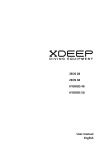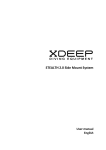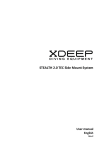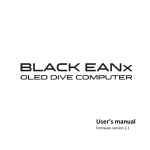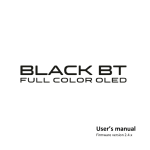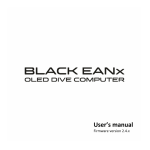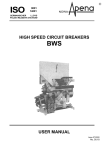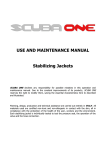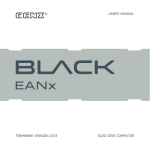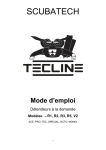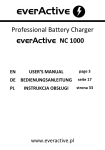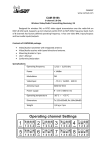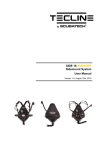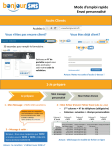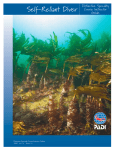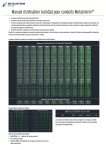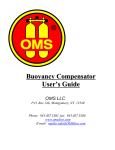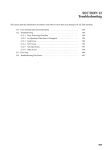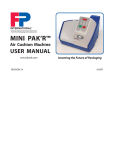Download User Manual - xDEEP Diving Equipment
Transcript
User Manual 1 Introduction Congratulations! You have purchased a perfect product in which, without any compromise, we have connected the best existing materials made in Europe and in the USA, with both our technical and recreational diving experience. While designing it, we have also consulted a considerable number of divers who use various configurations of equipment from many various producers. We hope that our product meets your expectations, regardless of whether you are a recreational diver or an experienced tech diver. Pre-use guidelines Before you use any of the products described in this manual, carefully read all the information contained herein with comprehension. Becoming familiar with this information is a prerequisite for safe and long-term use of the products described in this document. This manual is intended as a guide for correctly trained divers, and so a number of matters related to diving are described here only roughly. In no way can this manual act as a substitute for professional diver training or course. Therefore, before you start using any of the products described in this manual, make sure that you have relevant qualifications issued by a registered diving organization. If any of the information contained in this manual or if any information label placed on the Buoyancy Compensation Device is not clear, contact the manufacturer for explanation: WRECKANDREEF Piotr Czernik Ul.Ogrodników 3, 43-227 Góra Poland Phone: +48 12 44 66 998 e-mail: [email protected] Important! This manual includes two types of designation, which you should pay special attention to. They indicate warnings or other information which may be crucial for health and life of the user or other people. You should read them with special attention: Danger! Indicates an imminently hazardous situation which, if not avoided, will result in a serious accident which may cause death or serious injury. Warning! Indicates a potentially hazardous situation which, if not avoided, could cause damage to the product or serious injury. It may also indicate wrong and dangerous practices. 2 CE certification The products described in the following instruction have been a subject of certification in a recognized unit and meet the requirements of 89/686/EWG directive and of the norm EN1809:2001, synchronized with this directive, in its full extent; and of EN 250:2003 covering scuba harness. The compliance assessment of GHOST compensator and NextGEN diving harness was performed by: Polski Rejestr Statków S.A., Jednostka notyfikowana nr 1463 Al.Gen.Józefa Hallera 126 80-416 Gdaosk Polska GHOST buoyancy compensators has been certified as compatible with 89/686/EWG directive, as far as it contains air compatible with EN 12021 norm. Regarding the lack of EN norms for safety requirements while the use of it takes place with mixtures of higher oxygen content, the above mentioned buoyancy compensator cannot be regarded as one which has been a subject of CE certification with gas mixtures with oxygen level higher than 21% (+/- 2%) as stated in 89/686/EWG directive. Warning! In non-EU countries additional conditions, law requirements and buoyancy compensator norms may exist. Double check the current requirements in the country in which you intend to use it. Warning! The buoyancy compensator is not a safety jacket: it does not guarantee a proper head-up position on the surface. 3 Safety rules Danger! xDEEP BCDs are designed to provide the user with safety and comfort. Improper use may result in an accident, therefore it is necessary to comply with ALL of the following rules. 1. Before every dive, carefully inspect all elements of the equipment, including the BC. For further information on the subject, read: “Pre-dive inspection”. 2. Do not dive with the BC if there are signs of defective operation, damage or wear, such a BC should be withdrawn from use until it is repaired by an authorized WreckAndReef distributor. 3. During diving, perform mutual buddy-check, visually inspecting the BC against any leakages or other irregularities. Arrange checkout procedures with your buddy and practice relevant diving signs once again before diving. 4. In case of an uncontrolled ascent, you should immediately start releasing air from the BC in order to stop or slow down the rate of ascent. 5. In order not to drown as a result of an uncontrolled descent, in all cases you should be able to use an emergency source of buoyancy or remove the weight. The BC CANNOT be the only source of buoyancy! 6. Do not use your BC to lift or bring heavy objects to the surface. Doing so may result in a serious accident due to damage done to the BC or an uncontrolled ascent. For bringing objects heavier than 2kg, use appropriate equipment, such as a lift bag. 7. To prevent the BC from damage, avoid prolonged exposure of your BC to direct sunlight or extreme heat and keep it away from sharp objects. 8. Do not inhale air from the BC. It may contain harmful contaminants, gases, or dangerous bacteria which evolve in damp places. 9. A BC is not a lifejacket and does not guarantee a head-up position of the user on the surface. Therefore, you should always dive with a buddy in case of losing consciousness on the surface. 10. Do not lift or move the BC by pulling the inflator hose. Such practice may result in irreparable damage to the BC. 11. When diving in cold water (below 10 degrees Celsius), you should take into account that the inflator may freeze, as a result of which, it may supply air in an uncontrolled way, or other irregularities in its operation may appear. Before diving in cold water, it is necessary that you practice emergency procedures should the inflator freeze! 4 Parts of GHOST system 1/2 GHOST system consists of two basic elements: • • GHOST bladder; NextGEN diving harness of M or XL size, in basic or easy-to-unfasten version. GHOST buoyancy compensator may be equipped, as an option, with two-part weight pockets installed in NextGEN harness (see Chapter 6 – ‘Optional droppable weights’) or trim pockets. On the following pages of this manual we described particular elements of the system and also their configuration and adjustment. 5 1 8 2 6 3 7 4 Fig. 1. GHOST BCD with basic harness 1. 2. 3. 4. 5. 6. 7. 8. Compensator bladder Shoulder strap Waist strap V-type crotch strap Inflator hose K-type inflator Over pressure relief valve Buckles for quick adjustment and unfastening of harness. Fig. 2. GHOST BCD with deluxe harness 5 Parts of GHOST system 2/2 K-type Power Inflator A K-type inflator is a reliable device made of shockproof technopolymer which is resistant to environmental conditions. The inflator valve is made of metal, which makes the inflator more resistant to freezing and it can be operated much longer than inflators made entirely of plastic. The inflator is equipped with an inflator button (1) to inflate the BC with air, a purge button (2) to deflate the BC or inflate it orally, and a mouthpiece (3) to release the air that is deflated or inhale the BC orally. 2 3 1 Fig. 3. K-type inflator 6 Optional droppable weight pockets GHOST system enables to install, on the waist strap, xDEEP two-part weight pockets of 2 x 3kg or 2 x 6kg. The pockets are mounted with bolts to the holes in the central part of the plate: Fig.4. Mount points of two-part weight pockets In order to install the pockets: 1. Remove the buckle and, if necessary, other elements from the waist strap (if installed); 2. Fix the pockets on the waist strap by interweaving the waist strap webbing through proper places in the weight pockets; 3. With the use of bolts supplied with the pockets, tighten the pockets to the plate through holes in the pocket webbing and do not forget about the washer. Attention: In case of special needs, it is possible to install the pockets closer to the buckle. Contact the manufacturer to obtain more information. 7 Optional trim pockets Although GHOST system provides perfect trim in most of the suits, in some cases (e.g. dry suit with very thick undersuit) you may need to have the weight distributed in a special manner. Depending on the needs, you can install additional trim pockets thanks to which you get the optimal distribution of the centre of gravity, regardless of the type of suit you use. Together with GHOST system you can use the following types of trim pockets: Standard trim pockets placed on straps to attach the tank or on additional strap of equal type placed anywhere on the tank (e.g. on tank stand): Fig. 5. Standard trim pockets Trim pockets of STEALTH 2.0 sidemount system which can be placed anywhere on the crotch strap useful in case you are turned upside down: Fig. 6. Trim pockets of STEALTH 2.0 system Trim pockets fixed permanently to the plate using proper holes (marked with a rim): Fig.7. Mount points of pockets to the plate 8 Adjusting 1/2 When you order a complete buoyancy set, you're going to receive all parts assembled and ready to use. However, to improve the comfort and safety of the user, in the end you should adjust the shoulder straps and the crotch strap. NextGEN harness is available in two sizes: M and XL. M-size harness is designed for people of 175cm in height and shorter, whereas XL-size harness for people taller than 175cm. The unique structure of NextGEN harness, providing automatic shortening of shoulder straps after you fasten the waist strap, combines the advantages of the traditional technical harness with easiness to put it on and take it off provided by the harness with easy-to-undo buckles. In most cases the set requires adjustment only before the first dive after the purchase and in the case of changing the suit, thanks to which, at all times, the user has a set providing optimal trim and stability. NextGEN harness is traditionally equipped with V-type crotch strap which distributes pressure on a larger area and at the same time improves comfort in particular when you dive with a scooter. If you prefer the traditional type of crotch strap, contact the producer to obtain information on how to attach it. In the basic version of harness the shoulder straps and the crotch strap are adjusted through shortening or lengthening the loop which forms at the end of the webbing. The following picture shows points where shoulder straps and crotch strap can be adjusted: Fig.8. Points where shoulder straps and V-type crotch strap can be adjusted in standard harness. In order to lengthen the shoulder or crotch strap, first insert the end of the webbing into the blocking buckle (stopper) and then take out the excess of the webbing at the side of the loop. In order to shorten the strap, do the opposite, i.e. first insert the webbing at the side of the loop into the blocking buckle and then take out the excess of the webbing at its loose end. 9 Adjusting 2/2 Fig.9. Strap adjustment – step 1 Fig.10. Strap adjustment – step 2 In the harness with quick-adjustment buckle you adjust the strap by pulling loose ends of the shoulder straps (tightening) or by bending the press of the buckle up (loosening). Fig.11. Adjustment of shoulder straps in easy-to-unfasten harness. Guidelines for how to adjust NextGEN harness: In properly adjusted NextGEN harness the waist strap should be placed exactly on the waist (you need to properly adjust the height at which the plate is installed as well as the length of shoulder straps). Too high or too low location of the waist strap will decrease your comfort. In NextGEN harness the waist strap shall be fastened so that it is placed onto shoulder straps. The fastening of the waist strap should press the shoulders straps to the body improving the adjustment of the harness. You need to take it into consideration while adjusting the harness and check the adjustment of shoulder straps after you fasten the waist strap. The length of the crotch strap should be so adjusted that after the fastening the waist strap falls downwards creating Y shape with the crotch strap. The crotch strap should not be too short since it could be more difficult to find it while putting on the harness. 9 Connecting the Scuba Tank 1/2 Danger! An incorrectly connected tank may unexpectedly detach from the harness. Such situation is extremely dangerous and may result in a serious accident or even death. Therefore the tank connection has to be inspected closely. Attention: GHOST buoyancy compensator is designed to be used with tanks of parameters indicated in technical specification included at the end of this manual. Using this compensator with other types of tanks, although physically possible, is not recommended. Upon designing GHOST system, we aimed at creating a compensator which will provide the trim and stability at an exceptionally high level. GHOST reveals its advantages when installed in an optimal place on the tank, namely so that the centre of gravity of the gas in the tank correlates with the centre of compensator buoyancy. Such position of the compensator provides ideal trim during the whole dive, regardless of the amount of gas in the tank. The following picture shows GHOST compensator optimally attached to aluminium 80cf tank commonly used in diving centres operating in warm water areas: Fig.12. Optimal height for attaching 80cf tank In order to help you find the perfect point where to attach the tank, GHOST provides the centre of buoyancy marker in the form of oval hole in the central part of the bladder. While attaching the tank, make sure the hole is placed in the middle of the cylinder (without the valve and tank neck). Attention: If with such position of the compensator relative to the tank you hit your head on the first stage regulator, lower the compensator with single tank adapter according to chapter 'Changing the height of attaching the tank'.”. 10 Connecting the Scuba Tank 2/2 In order to connect the tank with the BC in a reliable and safe manner you should connect the webbing as indicated in the pictures below: 1 2 3 4 Fig. 10. Installation of the tape the buckle Danger! Before connecting the tank, carefully wet the connecting straps. Otherwise they may loosen and the tank may slip out. 11 Changing the tank’s mounting height For shorter people, it is frequently a problem that they hit the head on the first stage regulator, which results in limiting the field of view and automatically assuming incorrect position by the user. Simple lowering the tank relative to the compensator is not a good solution due to two reasons: 1. usually, as a result, the trim becomes poorer since the compensator is placed too high compared to the centre of gravity of the gas in the diving tank. 2. in many cases it can be dangerous since too low position of the tank may cause the tank to slip out of the harness leading to serious accident (upper mounting strap will not totally fit onto the cylindrical part of the tank). GHOST system enables to change the position of the compensator with single tank adapter relative to the harness, making it possible, as a result, for shorter people to lower the diving tank and, at the same time, retain perfect trim and safe tank attachment. The adapter and buoyancy compensator are mounted to the harness with the use of three bolts the distribution of which is presented in the following picture: Fig. 14. Mounting bolts In order to lower the compensator and single tank adapter: 1. 2. 3. 4. 5. Remove the tank mounting straps from the adapter; Undo three nuts inside the tank adapter trough and remove the adapter from the harness together with the buoyancy compensator; Remove the bolts from the holes in the plate and then insert them in other holes taking into account the distance you need to adjust the compensator. Mount the buoyancy compensator and tank adapter; Making sure that the bolts do not fall out the holes, tighten the nuts remembering about the washers. Danger! Incorrect tightening of bolts mounting the single tank adapter may cause the tank to disconnect from the compensator. Carefully inspect whether all the three bolts are tightened correctly. 12 Connecting the LP hose To allow for proper operation of the inflator it must be connected to the LP port of the 1st stage of the regulator using the LP hose supplied with the BC. Danger! st LP hose connection using the 1 stage of the regulator must be made to the low pressure (LP) port only. Connection to the HP port may result in serious injuries as well as damage to the equipment. In order to connect the LP hose to the inflator you should gently pull at the sleeve of the LP hose’s nozzle (step 1), and then put the nozzle onto the quick connector (step 2), as presented in the pictures below: Fig. 25. LP hose connection (step 1) Fig. 26. LP hose connection (step 2) Warning! The inflator supply pressure value should be between 6 and 15 bar. Before connecting the inflator to the LP hose, make sure that the pressure from the regulator is within this range. 13 Pre-dive Inspection Before every dive it is necessary to follow the inspection procedures for checking the correct operation of all BC elements. Even if on a given day you have already dived using your BC, before diving again make sure that all of its elements are working correctly. 1. Check that no element of the BC show any signs of wear, paying particular attention to the condition of webbing, buckles, the outer shell and the LP hose. 2. Check whether all detachable elements are tightened correctly; those are: bolts, valves, hose adapter and single tank adapter (if applicable). 3. Check the BC’s oral inflation putting the inflator’s mouthpiece into your mouth and pressing the purge button while breathing out. Using this method, inflate the BC to at least half of its volume. 4. Press the inflator button until the automatic dump valve is activated. The automatic dump valve should open with a characteristic sound. The air supply should stop immediately after release of the inflator button. 5. Check the correctness of manual operation (opening) of the dump valve by pulling on its string. By doing so you should release air. 6. Inflate the BC using the inflator button and then press the purge button, checking whether air is being released from the oral inflator’s hole. Repeat this step a couple of times. 7. Inflate the BC using the inflator button and leave it fully inflated for 15 minutes. After the 15 minutes the BC should remain full. If it is not, do not use it until the defect is removed by an authorized WreckAndReef service center. 8. During descent, stop at three meters at the most and perform mutual buddy-check, visually inspecting the BC against any leakages. Caution: Air bubbles appearing on the outer shell do not necessarily mean leakage. They may result from air being stuck in the structure of the fabric or under the inner shell. 14 Operation Buoyancy on the surface In order to ensure maximum buoyancy on the surface, before getting into the water (or directly after ascending) inflate the BC using inflator button. Stop inflating the BC when the automatic dump valve activates. Danger! Before jumping into deep water from a boat or a bank inflate the BC using the inflator button. Getting into water with the BC not fully inflated may result in drowning! Descent In order to descend, press the purge button holding the inflator over your head. Use the purge button with care, as releasing too much air may result in an uncontrolled descent. Neutral buoyancy Maintain neutral buoyancy for a given depth during the dive, using the inflator and purge buttons as needed. In order to ensure precise control over buoyancy you should press the inflator button for a short moment. If more air needs to be added to the BC, press the inflator button for a short moment several times. During release of air from the BC hold the inflator over your head, so the air may escape freely. Ascent Ascending too quickly may result in decompression sickness. Therefore you must control the rate of ascent by gradually releasing the expanding air from the BC with the purge button. Danger! Ascending or reducing the depth level too quickly may result in decompression sickness (DCS). Always pay adequate attention to buoyancy control and respect the ascent rate limits. 15 Post-dive maintenance Disconnecting After diving, take out the weight from the weight pockets (if applicable), disconnect the LP hose from the inflator, and then disconnect the tank. Draining Inflate the BC orally using the purge button of the inflator. Next turn the BC to keep the automatic dump valve at the lowest point of the BC. Pull the valve string, at the same time pressing the BC with your hands to make water flow out by the open dump valve. Repeat the procedure until all water is removed from the BC. Rinsing Every time you use the BC in salt or chlorinated water, it should be rinsed thoroughly inside and out with fresh water. Never use hot water for rinsing! To rinse the BC inside, press the purge button of the inflator and fill the BC approximately ¼ full with water by means of a garden hose spout or other source of fresh water. Rotate the BC several times, and next drain it according to the above procedure. Warning! Do not press the inflator button when rinsing your BC! This may make damp and other contaminants enter the inflator valve, which may cause subsequent damage to the valve. Drying After every use, you should dry the BC thoroughly. When drying, the BC should be fully inflated and hung in a dry, airy and dark place. When drying, do not expose your BC to direct sunlight or extreme heat! Storing Store your BC partially inflated and hung in a dry and dark place away from sharp objects, lubricants, fuels or solvents. Warning! To prevent your BC from damage, you should never keep it wet for a longer period than a dozen or so hours. 16 Repair and maintenance xDEEP BCDs does not contain any elements which can be repaired by the user, and so all repairs (including lubrication or replacement of worn-out elements) should be performed only by trained technicians holding certificates issued by the producer (authorized service center). For repair of xDEEP BCDs, only elements and spare parts supplied by the producer must be used. Elements and spare parts from other sources, although identical by all appearances, may have slightly different properties, which may negatively affect the working life of the BC. The only maintenance procedure which may be performed by the user is rinsing the BC in fresh water. It is recommended after diving in salt or chlorinated water. On no account should detergents, cleaning agents or solvents be used for cleaning the BC. In case of heavy soil, contact the producer for additional information. Warning! For safety reasons, the BC should be overhauled after every 200 dives, however not less frequently than once a year. Such overhaul should be performed by an authorised xDEEP service centre. 17 Technical specification Basic parameters Typ Single shell toroidal type BCD Buoyancy 17 kg Bladder fabric Cordura 1100 dTEX Mounting bolts displacement 11 cali (27.94 cm) Dry weight (without the harness) 0.65 kg Inflator Type K-type Working pressure range From 6 bar to 17.23 bar (250 PSI) Permisible tank parameters Type Single tank Size 15 L Diameter From 140 mm to 220 mm Operating temperatures Water From -2°C to 40°C Air From -20°C to 60°C xDEEP Ul.Ogrodników 3 43-227 Góra Polska Tel: +48 12 44 66 998 e-mail: [email protected]




















